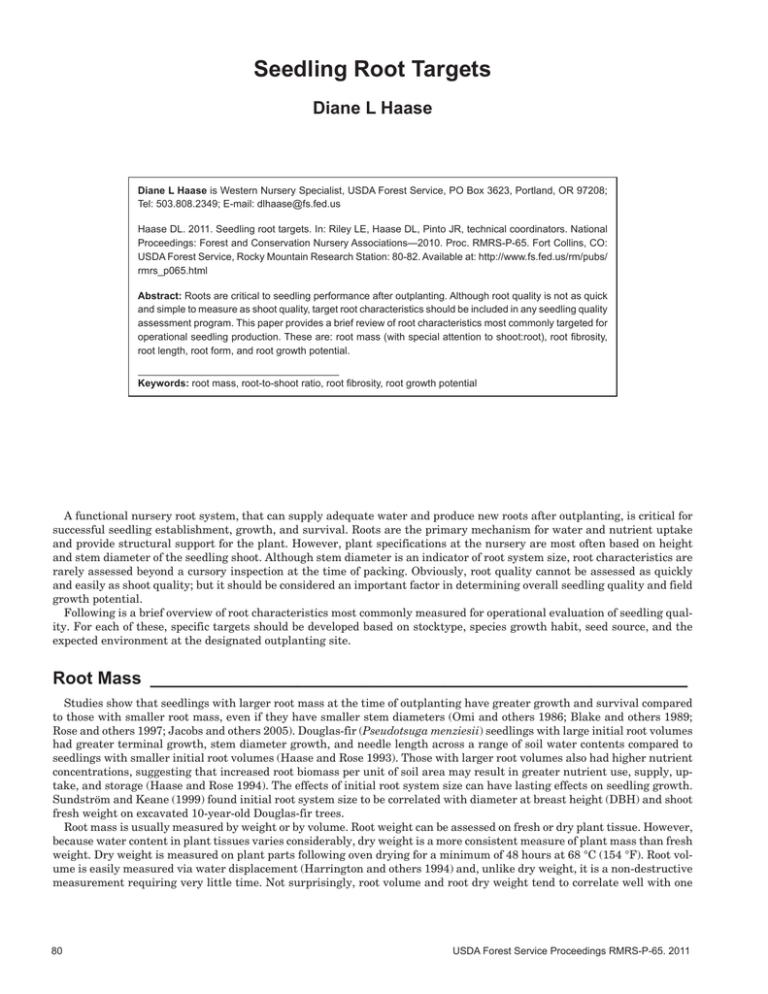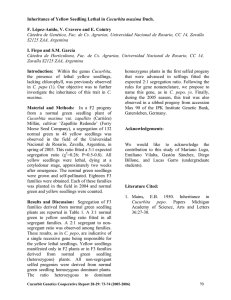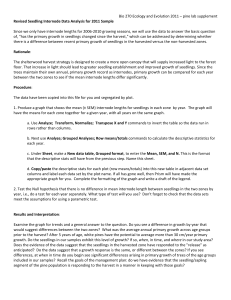Seedling Root Targets Diane L Haase
advertisement

Seedling Root Targets Diane L Haase Diane L Haase is Western Nursery Specialist, USDA Forest Service, PO Box 3623, Portland, OR 97208; Tel: 503.808.2349; E-mail: dlhaase@fs.fed.us Haase DL. 2011. Seedling root targets. In: Riley LE, Haase DL, Pinto JR, technical coordinators. National Proceedings: Forest and Conservation Nursery Associations—2010. Proc. RMRS-P-65. Fort Collins, CO: USDA Forest Service, Rocky Mountain Research Station: 80-82. Available at: http://www.fs.fed.us/rm/pubs/ rmrs_p065.html Abstract: Roots are critical to seedling performance after outplanting. Although root quality is not as quick and simple to measure as shoot quality, target root characteristics should be included in any seedling quality assessment program. This paper provides a brief review of root characteristics most commonly targeted for operational seedling production. These are: root mass (with special attention to shoot:root), root fibrosity, root length, root form, and root growth potential. Keywords: root mass, root-to-shoot ratio, root fibrosity, root growth potential A functional nursery root system, that can supply adequate water and produce new roots after outplanting, is critical for successful seedling establishment, growth, and survival. Roots are the primary mechanism for water and nutrient uptake and provide structural support for the plant. However, plant specifications at the nursery are most often based on height and stem diameter of the seedling shoot. Although stem diameter is an indicator of root system size, root characteristics are rarely assessed beyond a cursory inspection at the time of packing. Obviously, root quality cannot be assessed as quickly and easily as shoot quality; but it should be considered an important factor in determining overall seedling quality and field growth potential. Following is a brief overview of root characteristics most commonly measured for operational evaluation of seedling quality. For each of these, specific targets should be developed based on stocktype, species growth habit, seed source, and the expected environment at the designated outplanting site. Root Mass________________________________________________________ Studies show that seedlings with larger root mass at the time of outplanting have greater growth and survival compared to those with smaller root mass, even if they have smaller stem diameters (Omi and others 1986; Blake and others 1989; Rose and others 1997; Jacobs and others 2005). Douglas-fir (Pseudotsuga menziesii) seedlings with large initial root volumes had greater terminal growth, stem diameter growth, and needle length across a range of soil water contents compared to seedlings with smaller initial root volumes (Haase and Rose 1993). Those with larger root volumes also had higher nutrient concentrations, suggesting that increased root biomass per unit of soil area may result in greater nutrient use, supply, uptake, and storage (Haase and Rose 1994). The effects of initial root system size can have lasting effects on seedling growth. Sundström and Keane (1999) found initial root system size to be correlated with diameter at breast height (DBH) and shoot fresh weight on excavated 10-year-old Douglas-fir trees. Root mass is usually measured by weight or by volume. Root weight can be assessed on fresh or dry plant tissue. However, because water content in plant tissues varies considerably, dry weight is a more consistent measure of plant mass than fresh weight. Dry weight is measured on plant parts following oven drying for a minimum of 48 hours at 68 °C (154 °F). Root volume is easily measured via water displacement (Harrington and others 1994) and, unlike dry weight, it is a non-destructive measurement requiring very little time. Not surprisingly, root volume and root dry weight tend to correlate well with one 80 USDA Forest Service Proceedings RMRS-P-65. 2011 Seedling Root Targets another. It is important to note that root mass is not necessarily a reflection of root fibrosity (see section below); a highly fibrous seedling with many fine roots may have a root mass similar to a seedling with a large tap root and low fibrosity. Setting targets for root mass is dependent on the stocktype, seed source, and species. For instance, a quality 1+0 bareroot, loblolly pine (Pinus taeda) seedling may have an average root volume of 3 to 5 cm3 (0.18 to 0.24 in3), whereas a quality plug+1 bareroot, coastal Douglas-fir seedling may average 25 to 35 cm3 (1.5 to 2.1 in3). Shoot:Root_____________________ When setting targets for root mass of a specific seedling crop, it is imperative that those targets be set relative to the shoot mass. A quality seedling must have an appropriate balance between its capacity to absorb water (roots) and its transpirational area (shoot). The ratio between the shoot to root (shoot:root) is calculated from shoot and root volumes or dry weights. A typical shoot:root target is 3:1 or less for bareroot seedlings and 2:1 or less for container seedlings. These targets are particularly important for seedlings designated for outplanting sites where water is limiting; seedlings that are “top heavy” may perform poorly on dry sites if the root system is inadequate to supply the water needs of the shoot. Root Fibrosity__________________ Seedlings with a proliferation of lateral roots (fibrosity) generally perform better than those with few lateral roots (Wilson and others 2007). A fibrous root system has a relatively high surface area with many root apices. Determination of fibrosity is often by visual inspection of the “moppiness” of the roots or by counting the number of lateral roots originating from the tap root, (referred to as first-order lateral roots [FOLR]). For seedlings that are strongly tap rooted (such as many pines and hardwoods), the number of FOLR >1 mm (0.04 in) diameter can be a useful target characteristic for quantifying fibrosity and predicting growth (Davis and Jacobs 2005; Gould and Harrington 2009). Schultz and Thompson (1996) found greater survival and growth for red oak (Quercus rubra) seedlings with at least five FOLR and black walnut (Juglans nigra) seedlings with at least seven FOLR. Root Length____________________ Root length is often determined by culturing and pruning methods in bareroot seedlings or by the container depth and dimensions for container seedlings. For bareroot seedlings, target specifications for final root length are met through culturing in the nursery beds (undercutting and wrenching) and by root pruning at the time of packing (based on target specifications agreed upon by the grower and the customer). Root length targets are dictated by the desired balance of the plant (that is, shoot:root), conditions of the outplanting site (soil texture, depth, and moisture), and planting method. USDA Forest Service Proceedings RMRS-P-65. 2011 Haase Root Form_____________________ The criteria for root form quality are based on ease of handling and influence on future growth. Container seedlings rarely have issues with root form because the root systems develop in a defined space and shape. The main concern with container seedling roots is that they fill the container and create a firm, but not root bound, plug. Conversely, bareroot seedlings may have stiff lateral roots or other deformities that make them difficult to pack in storage containers or carry in a planting bag—these seedlings are generally culled. Additionally, deformities such as root sweep (often caused during transplanting) are culled because they may result in poor structural support after outplanting. Root Growth Potential____________ Root growth potential or capacity (RGP or RGC) of a seedling is its ability to initiate and elongate new roots when placed into an optimal environment. RGP is usually measured in late winter or early spring by either potting a sample of seedlings or placing them into a hydroponic tank. Subsequent root growth is quantified following a specified duration in an environment favorable for root growth (typically 2 to 4 weeks in a greenhouse environment where plants are kept moist and temperatures are 65 to 75°F [18 to 24°C]). New roots (distinguishable by their white tips) are then counted and measured. Quantification can either include all new roots or only those that are greater than 1 cm (0.4 in) long. Burdett (1979) developed an index of six RGP classes as follows: Class 0 1 2 3 4 5 Description no new root growth some new roots but none over 1 cm long 1 to 3 new roots over 1 cm long 4 to 10 new roots over 1 cm long 11 to 30 new roots over 1 cm long more than 30 new roots over 1 cm long Because RGP is assessed in a favorable environment for new root growth, the same growth may not be realized when the seedling is outplanted to field conditions with cool soil temperatures. RGP tests are also a reflection of physiology at a single point in time; a seedling’s physiological quality is subject to change from harvesting right up until outplanting. As such, RGP is not necessarily a good predictor of early field performance (Simpson and Ritchie 1997). In a study comparing 1+1 bareroot and 1+0 container seedlings, container seedlings had higher RGP than bareroot seedlings prior to outplanting as well as more root and shoot growth during the spring after outplanting; in the fall following outplanting, however, bareroot seedling survival and root growth were similar to container seedlings and subsequent long-term performance was expected to be comparable between the two stocktypes (Rose and Haase 2005). Despite not being able to predict field performance through a range of conditions, RGP may be useful for identifying seedling viability. Using Douglas-fir, van den Driessche (1987, 1991) demonstrated that new root growth is dependent on 81 Haase Seedling Root Targets current photosynthesis. The connection between new root growth and photosynthesis is dependent on many physiological functions including stomatal regulation, plant moisture status, photosynthate translocation, and so on; a high RGP result, therefore, will indicate a seedling is alive and well at the time of testing. Conversely, if a seedling tested very low, it is likely an indication that one of these systems is compromised. Summary______________________ When developing target characteristics for seedling quality, root morphological parameters such as mass, fibrosity, length, and form are important to include. Targets for root size should always be made relative to the shoot size to ensure a proper balance between the plant’s water supply (roots) and demand (shoots). Root growth potential is another characteristic that may be considered, although its link to field performance can be uncertain. As with any quality characteristics, determining specific root target ranges is based on stocktype, growth habit of the plant species, and environmental conditions of the outplanting site. References_____________________ Blake JI, Teeter LD, South DB. 1989. Analysis of the economic benefits from increasing uniformity in Douglas-fir nursery stock. In: Mason WL, Deans JD,Thompson S, editors. Producting uniform conifer planting stock. Forestry Supplement 62:251-262. Burdett AN. 1979. New methods for measuring root growth capacity: their value in assessing lodgepole pine stock quality. Canadian Journal of Forest Research 9:63-67. Davis AS, Jacobs DF. 2005. Quantifying root system quality of nursery seedlings and relationship to outplanting performance. New Forests 30:295-311. Gould P, Harrington CA. 2009. Root morphology and growth of bareroot seedlings of Oregon white oak. Tree Planters’ Notes 53:22-28. Haase DL, Rose R. 1993. Soil moisture stress induces transplant shock in stored and unstored 2 + 0 Douglas-fir seedlings of varying root volumes. Forest Science 39:275-294. Haase DL, Rose R. 1994. Effects of soil water content and initial root volume on the nutrient status of 2+0 Douglas-fir seedlings. New Forests 8:265-277. Harrington JT, Mexal JD, Fisher JT. 1994. Volume displacement method provides a quick and accurate way to quantify new root production. Tree Planters’ Notes 45:121-124. Jacobs DF, Salifu KF, Seifert JR. 2005. Relative contribution of initial root and shoot morphology in predicting field performance of hardwood seedlings. New Forests 30:235-251. Omi SK, Howe GT, Duryea ML. 1986. First-year field performance of Douglas-fir seedlings in relation to nursery characteristics. In: Landis TD, editor. Proceedings, combined Western Forest Nursery Council and Intermountain Nursery Association meeting; 12-15 Aug 1986; Tumwater, WA. Fort Collins (CO): USDA Forest Service, Rocky Mountain Forest and Range Experiment Station USDA. General Technical Report RM 137. p 29-34. Rose R, Haase DL, Kroiher F, Sabin T. 1997. Root volume and growth of ponderosa pine and Douglas-fir seedlings: A summary of eight growing seasons. Western Journal of Applied Forestry 12:69-73. Rose R, Haase DL. 2005. Root and shoot allometry of bareroot and container Douglas-fir seedlings. New Forests 30:215-233. Schultz RC, Thompson JR. 1996. Effect of density control and undercutting on root morphology of 1+0 bareroot hardwood seedlings: five-year field performance of root-graded stock in the central USA. New Forests 13:301-314. Simpson DG, Ritchie GA. 1997. Does RGP predict field performance? A debate. New Forests 13:253-277. Sundström E, Keane M. 1999. Root architecture, early development and basal sweep in containerized and bare-rooted Douglas fir (Pseudotsuga menziesii). Plant and Soil 217:65-78. van den Driessche. 1987. Importance of current photosynthesis to new root growth in planted conifer seedlings. Canadian Journal of Forest Research 17:776-782. van den Driessche. 1991. Influence of container nursery regimes on drought resistance of seedlings following planting. I. Survival and growth. Can Journal of Forest Research 21:555-565. Wilson ER, Vitols KC, Park A. 2007. Root characteristics and growth potential of container and bare-root seedlings of red oak (Quercus rubra L.) in Ontario, Canada. New Forests. 34: 163-176. The content of this paper reflects the views of the authors, who are responsible for the facts and accuracy of the information presented herein. 82 USDA Forest Service Proceedings RMRS-P-65. 2011





